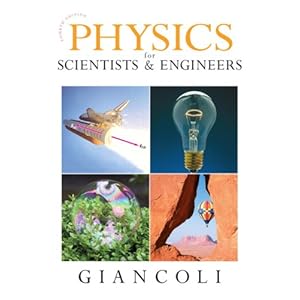Physics for Scientists & Engineers, Chapters 1-37, 4th Edition
 点此进入淘宝搜索页搜索
点此进入淘宝搜索页搜索分類: 图书,进口原版,Professional & Technical(专业与技术类),
品牌: Douglas C. Giancoli
基本信息出版社:Prentice Hall; 4 (2007年12月20日)精装:1104页正文语种:英语ISBN:0132275597条形码:9780132275590商品尺寸:28.5 x 22.1 x 3.9 cm商品重量:2.4 KgASIN:0132275597商品描述内容简介Key Message:This book aims to explain physics in a readable and interesting manner that is accessible and clear, and to teach readers by anticipating their needs and difficulties without oversimplifying. Physics is a description of reality, and thus each topic begins with concrete observations and experiences that readers can directly relate to. We then move on to the generalizations and more formal treatment of the topic. Not only does this make the material more interesting and easier to understand, but it is closer to the way physics is actually practiced.
Key Topics:
INTRODUCTION, MEASUREMENT, ESTIMATING, DESCRIBING MOTION: KINEMATICS IN ONE DIMENSION, KINEMATICS IN TWO OR THREE DIMENSIONS; VECTORS, DYNAMICS: NEWTON’S LAWS OF MOTION , USING NEWTON’S LAWS: FRICTION, CIRCULAR MOTION, DRAG FORCES , GRAVITATION AND NEWTON’S6 SYNTHESIS , WORK AND ENERGY , CONSERVATION OF ENERGY , LINEAR MOMENTUM , ROTATIONAL MOTION , ANGULAR MOMENTUM; GENERAL ROTATION , STATIC EQUILIBRIUM; ELASTICITY AND FRACTURE , FLUIDS , OSCILLATIONS , WAVE MOTION, SOUND , TEMPERATURE, THERMAL EXPANSION, AND THE IDEAL GAS LAW
KINETIC THEORY OF GASES , HEAT AND THE FIRST LAW OF THERMODYNAMICS , SECOND LAW OF THERMODYNAMICS
ELECTRIC CHARGE AND ELECTRIC FIELD, GAUSS’S LAW , ELECTRIC POTENTIAL , CAPACITANCE, DIELECTRICS, ELECTRIC ENERGY STORAGE , ELECTRIC CURRENTS AND RESISTANCE , DC CIRCUITS, MAGNETISM, SOURCES OF MAGNETIC FIELD, ELECTROMAGNETIC INDUCTION AND FARADAY’S LAW, INDUCTANCE, ELECTROMAGNETIC OSCILLATIONS, AND AC CIRCUITS
MAXWELL’S EQUATIONS AND ELECTROMAGNETIC WAVES, LIGHT: REFLECTION AND REFRACTION, LENSES AND OPTICAL INSTRUMENTS, THE WAVE NATURE OF LIGHT; INTERFERENCE, DIFFRACTION AND POLARIZATION, SPECIAL THEORY OF RELATIVITY
EARLY QUANTUM THEORY AND MODELS OF THE ATOM
Market Description:This book is written for readers interested in learning the basics of physics.
目录
CONTENTS OF VOLUME 1
APPLICATIONS LIST xii
PREFACE xiv
AVAILABLE SUPPLEMENTS AND MEDIA xxii
NOTES TO STUDENTS (AND INSTRUCTORS) ON THE FORMAT xxiv
COLOR USE: VECTORS, FIELDS, AND SYMBOLS xxv
CHAPTER1: INTRODUCTION, MEASUREMENT, ESTIMATING
1—1 The Nature of Science
1—2 Models, Theories, and Laws
1—3 Measurement and Uncertainty; Significant Figures
1—4 Units, Standards, and the SI System
1—5 Converting Units
1—6 Order of Magnitude: Rapid Estimating
*1—7 Dimensions and Dimensional Analysis
SUMMARY
QUESTIONS
PROBLEMS
GENERAL PROBLEMS
CHAPTER 2: DESCRIBING MOTION: KINEMATICS IN ONE DIMENSION
2—1 Reference Frames and Displacement
2—2 Average Velocity
2—3 Instantaneous Velocity
2—4 Acceleration
2—5 Motion at Constant Acceleration
2—6 Solving Problems
2—7 Freely Falling Objects
*2—8 Variable Acceleration; Integral Calculus
*2—9 Graphical Analysis and Numerical Integration
SUMMARY
QUESTIONS
PROBLEMS
GENERAL PROBLEMS
CHAPTER 3: KINEMATICS IN TWO OR THREE DIMENSIONS; VECTORS
3—1 Vectors and Scalars
3—2 Addition of Vectors–Graphical Methods
3—3 Subtraction of Vectors, and Multiplication of a Vector by a Scalar
3—4 Adding Vectors by Components
3—5 Unit Vectors
3—6 Vector Kinematics
3—7 Projectile Motion
3—8 Solving Problems Involving Projectile Motion
3—9 Relative Velocity
SUMMARY
QUESTIONS
PROBLEMS
GENERAL PROBLEMS
CHAPTER 4: DYNAMICS: NEWTON’S LAWS OF MOTION
4—1 Force
4—2 Newton’s First Law of Motion
4—3 Mass
4—4 Newton’s Second Law of Motion
4—5 Newton’s Third Law of Motion
4—6 Weight–the Force of Gravity; and the Normal Force
4—7 Solving Problems with Newton’s Laws: Free-Body Diagrams
4—8 Problem Solving–A General Approach
SUMMARY
QUESTIONS
PROBLEMS
GENERAL PROBLEMS
CHAPTER 5: USING NEWTON’S LAWS: FRICTION, CIRCULAR MOTION, DRAG FORCES
5—1 Applications of Newton’s Laws Involving Friction
5—2 Uniform Circular Motion–Kinematics
5—3 Dynamics of Uniform Circular Motion
5—4 Highway Curves: Banked and Unbanked
*5—5 Nonuniform Circular Motion
*5—6 Velocity-Dependent Forces: Drag and Terminal Velocity
SUMMARY
QUESTIONS
PROBLEMS
GENERAL PROBLEMS
CHAPTER 6: GRAVITATION AND NEWTON’S6 SYNTHESIS
6—1 Newton’s Law of Universal Gravitation
6—2 Vector Form of Newton’s Law of Universal Gravitation
6—3 Gravity Near the Earth’s Surface; Geophysical Applications
6—4 Satellites and “Weightlessness”
6—5 Kepler’s Laws and Newton’s Synthesis
*6—6 Gravitational Field
6—7 Types of Forces in Nature
*6—8 Principle of Equivalence; Curvature of Space; Black Holes
SUMMARY
QUESTIONS
PROBLEMS
GENERAL PROBLEMS
CHAPTER 7: WORK AND ENERGY
7—1 Work Done by a Constant Force
7—2 Scalar Product of Two Vectors
7—3 Work Done by a Varying Force
7—4 Kinetic Energy and the Work-Energy Principle
SUMMARY
QUESTIONS
PROBLEMS
GENERAL PROBLEMS
CHAPTER 8: CONSERVATION OF ENERGY
8—1 Conservative and Nonconservative Forces
8—2 Potential Energy
8—3 Mechanical Energy and Its Conservation
8—4 Problem Solving Using Conservation of Mechanical Energy
8—5 The Law of Conservation of Energy
8—6 Energy Conservation with Dissipative Forces: Solving Problems
8—7 Gravitational Potential Energy and Escape Velocity
8—8 Power
*8—9 Potential Energy Diagrams; Stable and Unstable Equilibrium
SUMMARY
QUESTIONS
PROBLEMS
GENERAL PROBLEMS
CHAPTER 9: LINEAR MOMENTUM
9—1 Momentum and Its Relation to Force
9—2 Conservation of Momentum
9—3 Collisions and Impulse
9—4 Conservation of Energy and Momentum in Collisions
9—5 Elastic Collisions in One Dimension
9—6 Inelastic Collisions
9—7 Collisions in Two or Three Dimensions
9—8 Center of Mass (CM)
9—9 Center of Mass and Translational Motion
*9—10 Systems of Variable Mass; Rocket Propulsion
SUMMARY
QUESTIONS
PROBLEMS
GENERAL PROBLEMS
CHAPTER 10: ROTATIONAL MOTION
10—1 Angular Quantities
10—2 Vector Nature of Angular Quantities
10—3 Constant Angular Acceleration
10—4 Torque
10—5 Rotational Dynamics; Torque and Rotational Inertia
10—6 Solving Problems in Rotational Dynamics
10—7 Determining Moments of Inertia
10—8 Rotational Kinetic Energy
10—9 Rotational Plus Translational Motion; Rolling
*10—10 Why Does a Rolling Sphere Slow Down?
SUMMARY
QUESTIONS
PROBLEMS
GENERAL PROBLEMS
CHAPTER 11: ANGULAR MOMENTUM; GENERAL ROTATION
11—1 Angular Momentum–Object Rotating About a Fixed Axis
11—2 Vector Cross Product; Torque as a Vector
11—3 Angular Momentum of a Particle
11—4 Angular Momentum and Torque for a System of Particles; General Motion
11—5 Angular Momentum and Torque for a Rigid Object
11—6 Conservation of Angular Momentum
*11—7 The Spinning Top and Gyroscope
*11—8 Rotating Frames of Reference; Inertial Forces
*11—9 The Coriolis Effect





